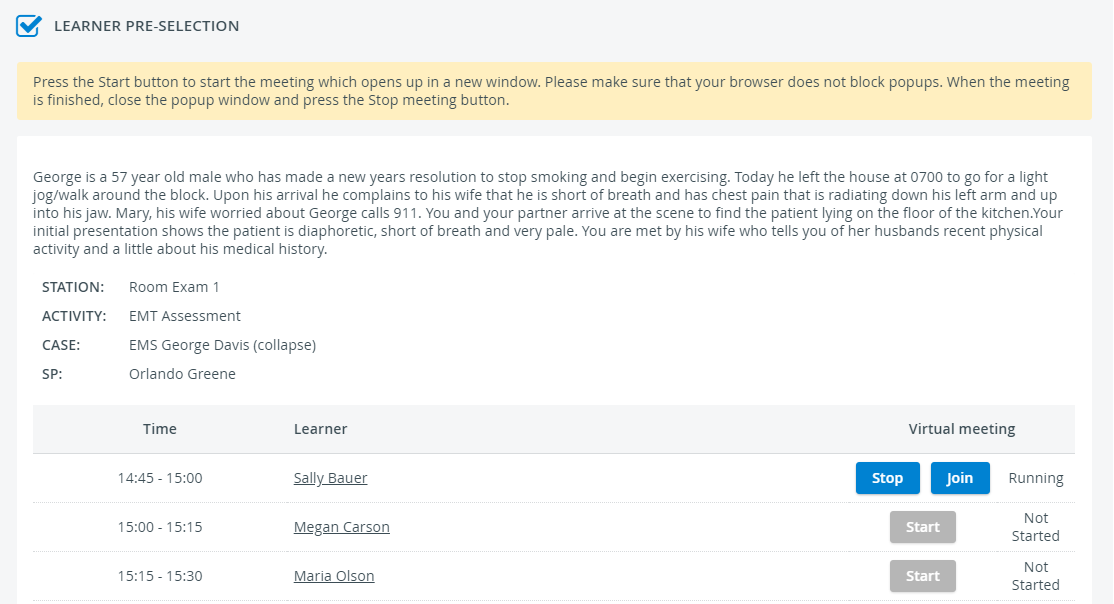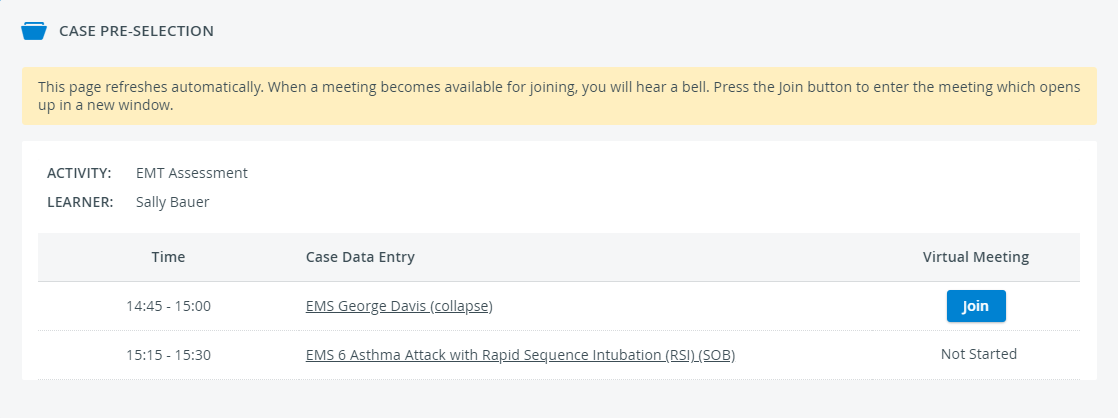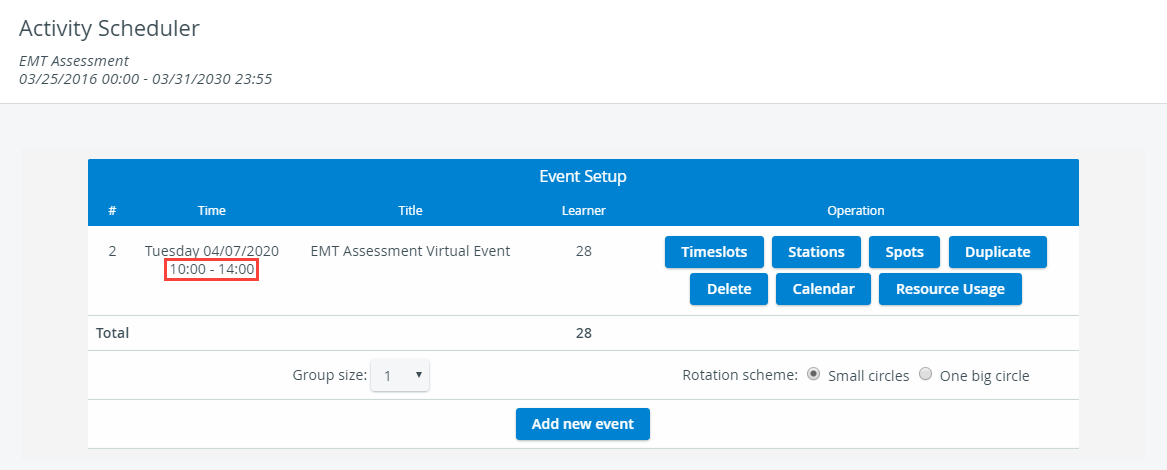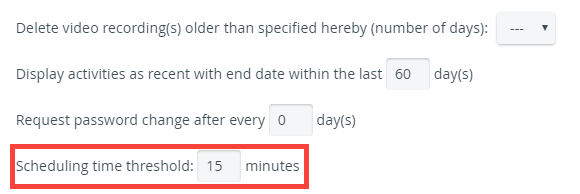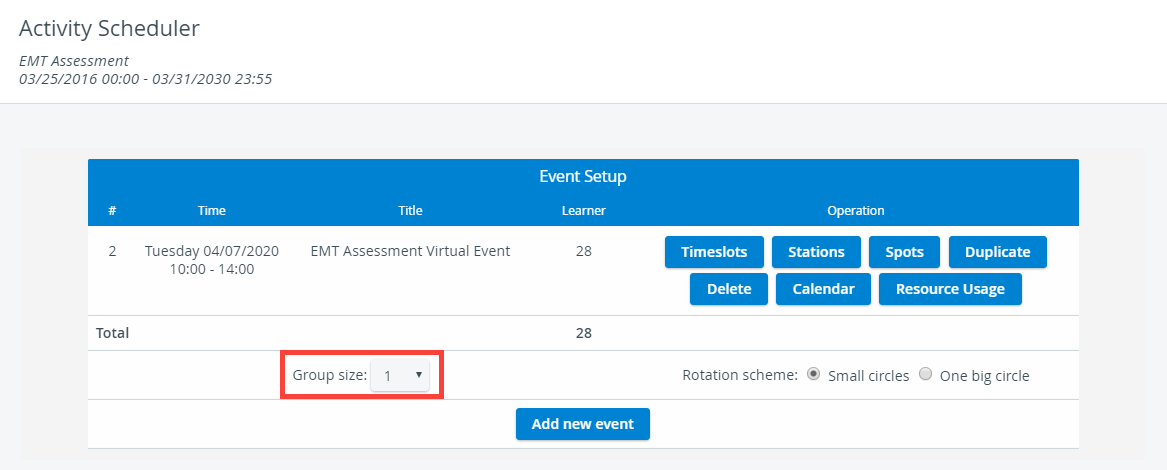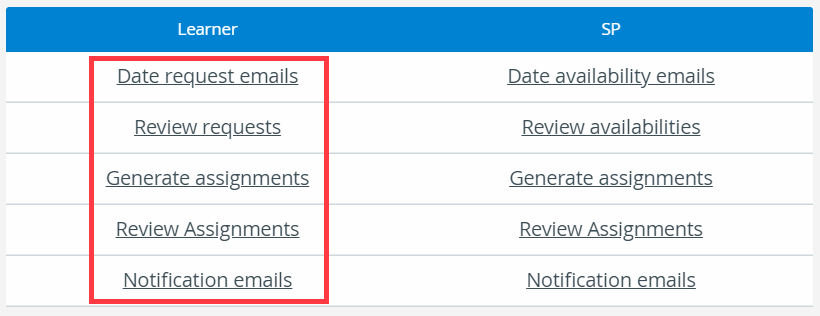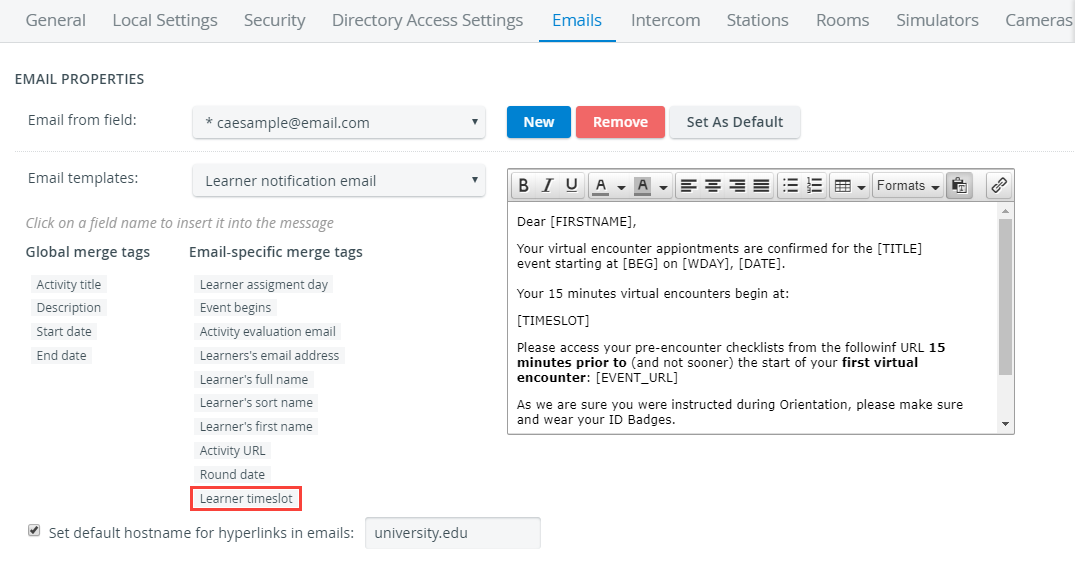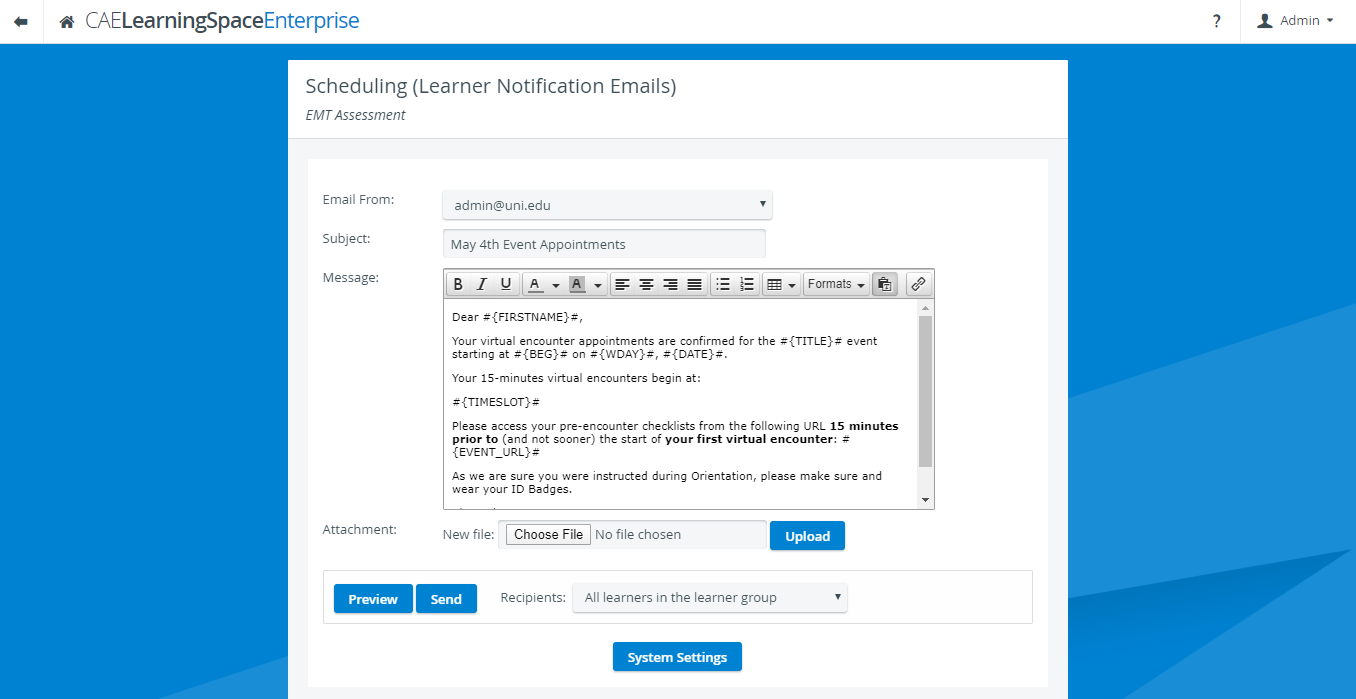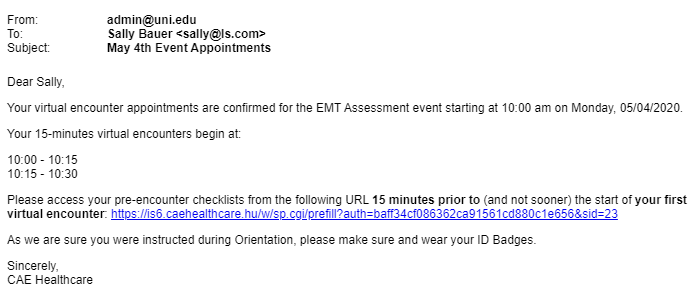This page will walk you through the most important advances, the steps of creating a virtual event, and other essential settings to optimize the virtual OSCE workflow:
Create users with combined Activity Manager + SRP or + SRP (full control) privileges. With this combination, the user can edit the activity that was shared with them for reading and writing; at the same time, they will have access to Advanced Scheduling.
Important Changes
1. Renewed Pre-Selection Pages
The Case Pre-Selection (for learners) and Learner Pre-Selection (for SPs) pages contain new options:
Duration of Pre-Selection Page Display
Pre-Selection pages are only available for SPs and learners from the start to finish of the event they are assigned to.
Otherwise, learners can only access data entry through the basic case selection page where they have to select a case from a drop-down manually:
Basic case selection page without virtual event details
This might result in accidentally filling out the wrong checklist.
Also, SPs will not be able to access the renewed Learner Pre-Selection page prior to or after the event.
Start/Stop meeting options for SPs to start hosting or end the virtual encounter from CAE LearningSpace.
Important - End a Meeting Properly
SPs need to end the meeting with the End Meeting for All option in Zoom and the Stop option in CAE LearningSpace to allow learners access to their post-encounter checklist.
Otherwise, video processing will not start, and learners will be presented with the following message when trying to access their post-encounter checklist:- Join option for learners to each virtual case listed by the timeslots the learners were assigned to.
2. Virtual Rooms Instead of Authorized Workstations
In a distance learning environment, virtual rooms cannot be applied as authorized workstations since every participant of the activity logs into CAE LearningSpace on their device.
a. Consequently, there are certain Options in the activity editor that must be avoided:
- Do not restrict data entry to specific computers based on their IP address or hostname endings.
Make sure "Data entry only allowed from..." setting is unchecked.
- Do not allow data entry from manually authorized workstations.
Make sure "Data entry only allowed from manually authorized workstations" setting is unchecked.
b. Upon login, SPs and learners are not automatically forwarded to the
- Case Pre-Selection page (for learners) and
- Learner Pre-Selection page (for SPs).
This limits automated data entry presentation to these users.
Solution
During the event, SPs and learners need to go to their Dashboards and click SP Data Entry or Data Entry next to the activity they are participating in—as explained in the standardized patient and medical student guides—to access their Pre-Selection pages.
3. Video Processing
CAE LearningSpace uses Zoom's cloud storage as temporary storage: OSCE virtual encounters are first stored in Zoom's storage—upon each meeting is ended—, then they will be downloaded to the Video Review module in CAE LearningSpace.
Important
The recordings of the virtual encounters are not available until video processing is finished.
Virtual encounter recordings display the host and participant—SP and learner—side-by-side.
Annotations
CAE LearningSpace adds annotations to the recordings to let you know when the learner has joined the virtual encounter.
Recommended Activity Settings
1. Pre-Selection Page Display
Pre-Selection pages are only available for the duration of the event. Otherwise, SPs and learners can only access data entry from their basic data entry selection pages where they have to select a learner or a case from a drop-down manually.
Learners scheduled for the first or last timeslots of an event will have less time on their Case Pre-Selection pages, also SPs will not access their Learner Selection-Page to complete data entry right after their last virtual encounter.
Solution
To enable SPs and learners to access their Pre-Selection before and after an event for some extra time, set up a scheduling time threshold. (Scheduling time threshold applies to every event created in your CAE LearningSpace system.)
This setting will allow the learners assigned to the first and last timeslot(s) to access their pre- and post-encounter checklists from the Case Pre-Selection page to avoid any data entry mistake.
SPs can also conveniently finish up their data entry from their Learner Pre-Selection page.
Example
- You have a virtual event scheduled from 10 a.m. that ends at 2 p.m:
In the current state of the event, virtual meeting Pre-Selection pages are only available from 10 a.m to 2 p.m. - Go to System.
- On the General tab, scroll down to Scheduling time threshold
- Set your scheduling time threshold to 15 minutes.
- Now, Pre-Selection pages are available from 9:45 a.m. until 2:15 p.m.
When SPs and learners click on SP/Data Entry on their Dashboards between these dates, they will directed to their Pre-Selection pages mentioned previously at 1. Renewed Pre-Selection Pages.Note that meanwhile the start and end date of your event remain the same (10 a.m. - 2 p.m.).
2. Limit the Availability of Learner Data Entry
Even if you ensure that learners have plenty of time to access their Case Pre-Selection pages during the event, they can still access data entry during the entire activity.
If they access Data Entry outside of the event and the scheduling time threshold, they will land on the basic case selection page without the context of the event they are assigned to.
Solution
Align the activity's entire duration with the event's duration extended by the scheduling threshold:
This way, data entry will be only available through Pre-Selection pages.
- Schedule your virtual event (e.g. 10 a.m. - 2 p.m)
- Set a scheduling time threshold on the General tab in System:
Pre-Selection pages will be available from 9:45 a.m. until 2:15 p.m. - Go to the Dashboard, select and open the activity you are working on for editing.
- On the Basics tab, adjust the time of the entire activity to the event's duration extended by the scheduling time threshold:
3. Disable Post-Encounter Checklist Access Before the Virtual Encounter
After completing the above steps, access to checklists will be time-restricted.
Although, learners could still access their post-encounter checklist before their virtual encounter without applying the following restriction:
Solution
Select the "Allow Post-Encounter access only after student encounter" in the Options tab of the activity.
When selected, learners can only access their post-encounter checklist once the virtual meeting ended/was Stopped by the SP in CAE LearningSpace.
Virtual Event Setup
Create a new event with Advanced Scheduling.
Important
Virtual encounters can only be set up in Advanced Scheduling.
Only one learner can participate at a time in a virtual encounter, which means Group size must always be 1.
Check the Group size drop-down on the Activity Scheduler page of your activity at the bottom of the Event Setup pane and make sure it is set to 1.
Set up timeslots and have valid round setups.
Number of Timeslots
To allow your learners to join the virtual meeting of each case required of them, the number of timeslots within a round should be equal to (or the multiple of) the number of virtual cases.
This will ensure the correct rotation of learners: within one round, every one of them can participate in each virtual encounter they need to complete.Add one virtual room to each case at Stations.
You can conduct the same case in several different virtual rooms just as running the same case on more than one station.
Likewise physical rooms, you cannot assign the same virtual room to more than one case.
Do not add physical rooms to your virtual event or add virtual rooms and physical rooms simultaneously to virtual events.
Only virtual rooms work in this setting.Important
Virtual rooms do not function as authorized workstations, which means automatic user-forwarding to pre-selection pages is not provided.
Learners can still access their checklists, but they have to manually select their case from a drop-down menu, which might lead to mistakes in data entry.Refer to the Recommended Activity Settings mentioned above to direct your learners to the Case Pre-Selection page.
- assign one SP per case
Warning
Do not apply a timeslot structure template to your event.
SPs are in charge of launching and ending virtual encounters.
Notify Learners about Their Exact Timeslot Schedule
After assigning learners to timeslots, send the exact virtual encounter dates to your learners via notification emails.
Timeslot Dates
- Scroll down to Notification emails on the Activity Scheduler page:
You will be redirected to the Scheduling (Learner assignments) page where you can edit the notification email you are going to send out to the learners. Select a from address in the Email From drop-down.
To set up further from addresses, go to the Emails tab in System Manager.
- Enter the subject of your email in the Subject field.
- Edit the message body of your email in the Message field.
- While editing your message, apply the new Learner timeslot merge tag.
To apply the new merge tag, it first needs to be added to the Learner notification email template in Emails:
- Click on the System Settings button at the bottom of the page to access the Emails tab in System.
- Select "Learner notification email" from the Email templates drop-down:
- While editing the template, click on the Learner timeslot tag to add it to your message.
Return from the Emails tab to your event notification email setup using the back arrow.
The timeslot (#{TIMESLOT}#) tag will be added to your message: - Click on Preview to see how your email will be displayed to each of your recipients.
The Email Preview page displays your message by each user.
The timeslot merge tab will list every timeslot a learner has been assigned to:
Return to editing with the back arrow. - Select a recipient group from the Recipients drop-down.
Click Send.
After you have sent out the date request emails, the system will log the time and date of sending.

